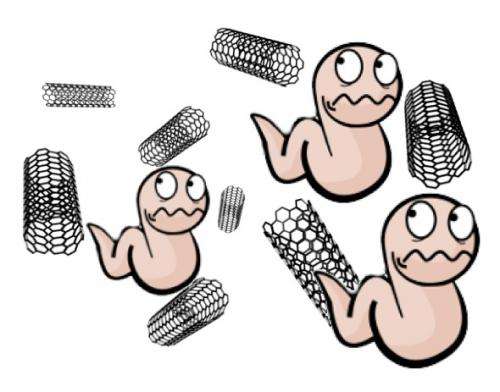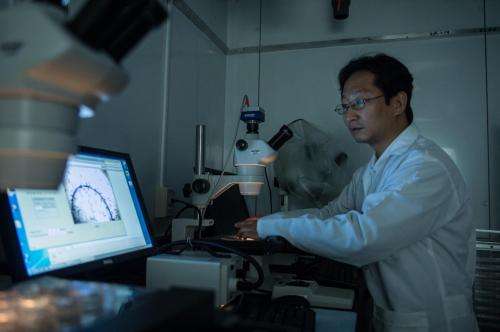Worms lead way to test nanoparticle toxicity

The lowly roundworm is the star of an ambitious Rice University project to measure the toxicity of nanoparticles.
The low-cost, high-throughput study by Rice scientists Weiwei Zhong and Qilin Li measures the effects of many types of nanoparticles not only on individual organisms but also on entire populations.
The Rice researchers tested 20 types of nanoparticles and determined that five, including the carbon-60 molecules ("buckyballs") discovered at Rice in 1985, showed little to no toxicity.
Others were moderately or highly toxic to Caenorhabditis elegans, several generations of which the researchers observed to see the particles' effects on their health.
The results were published by the American Chemical Society journal Environmental Sciences and Technology. They are also available on the researchers' open-source website.
"Nanoparticles are basically new materials, and we don't know much about what they will do to human health and the health of the ecosystem," said Li, an associate professor of civil and environmental engineering and of materials science and nanoengineering. "There have been a lot of publications showing certain nanomaterials are more toxic than others. So before we make more products that incorporate these nanomaterials, it's important that we understand we're not putting anything toxic into the environment or into consumer products.
"The question is, How much cost can we bear?" she said. "It's a long and expensive process to do a thorough toxicological study of any chemical, not just nanomaterials." She said that due to the large variety of nanomaterials being produced at high speed and at such a large scale, there is "an urgent need for high-throughput screening techniques to prioritize which to study more extensively."

Rice's pilot study proves it is possible to gather a lot of toxicity data at low cost, said Zhong, an assistant professor of biosciences, who has performed extensive studies on C. elegans, particularly on their gene networks. Materials alone for each assay, including the worms and the bacteria they consumed and the culture media, cost about 50 cents, she said.
The researchers used four assays to see how worms react to nanoparticles: fitness, movement, growth and lifespan. The most sensitive assay of toxicity was fitness. In this test, the researchers mixed the nanoparticles in solutions with the bacteria that worms consume. Measuring how much bacteria they ate over time served as a measure of the worms' "fitness."
"If the worms' health is affected by the nanoparticles, they reproduce less and eat less," Zhong said. "In the fitness assay, we monitor the worms for a week. That is long enough for us to monitor toxicity effects accumulated through three generations of worms." C. elegans has a life cycle of about three days, and since each can produce many offspring, a population that started at 50 would number more than 10,000 after a week. Such a large number of tested animals also enabled the fitness assay to be highly sensitive.
The researchers' "QuantWorm" system allowed fast monitoring of worm fitness, movement, growth and lifespan. In fact, monitoring the worms was probably the least time-intensive part of the project. Each nanomaterial required specific preparation to make sure it was soluble and could be delivered to the worms along with the bacteria. The chemical properties of each nanomaterial also needed to be characterized in detail.
The researchers studied a representative sampling of three classes of nanoparticles: metal, metal oxides and carbon-based. "We did not do polymeric nanoparticles because the type of polymers you can possibly have is endless," Li explained.
They examined the toxicity of each nanoparticle at four concentrations. Their results showed C-60 fullerenes, fullerol (a fullerene derivative), titanium dioxide, titanium dioxide-decorated nanotubes and cerium dioxide were the least damaging to worm populations.
Their "fitness" assay confirmed dose-dependent toxicity for carbon black, single- and multiwalled carbon nanotubes, graphene, graphene oxide, gold nanoparticles and fumed silicon dioxide.
They also determined the degree to which surface chemistry affected the toxicity of some particles. While amine-functionalized multiwalled nanotubes proved highly toxic, hydroxylated nanotubes had the least toxicity, with significant differences in fitness, body length and lifespan.
A complete and interactive toxicity chart for all of the tested materials is available online.
Zhong said the method could prove its worth as a rapid way for drug or other companies to narrow the range of nanoparticles they wish to put through more expensive, dedicated toxicology testing.
"Next, we hope to add environmental variables to the assays, for example, to mimic ultraviolet exposure or river water conditions in the solution to see how they affect toxicity," she said. "We also want to study the biological mechanism by which some particles are toxic to worms."
More information: Environmental Sciences and Technology, pubs.acs.org/doi/abs/10.1021/es5056462
Provided by Rice University


















